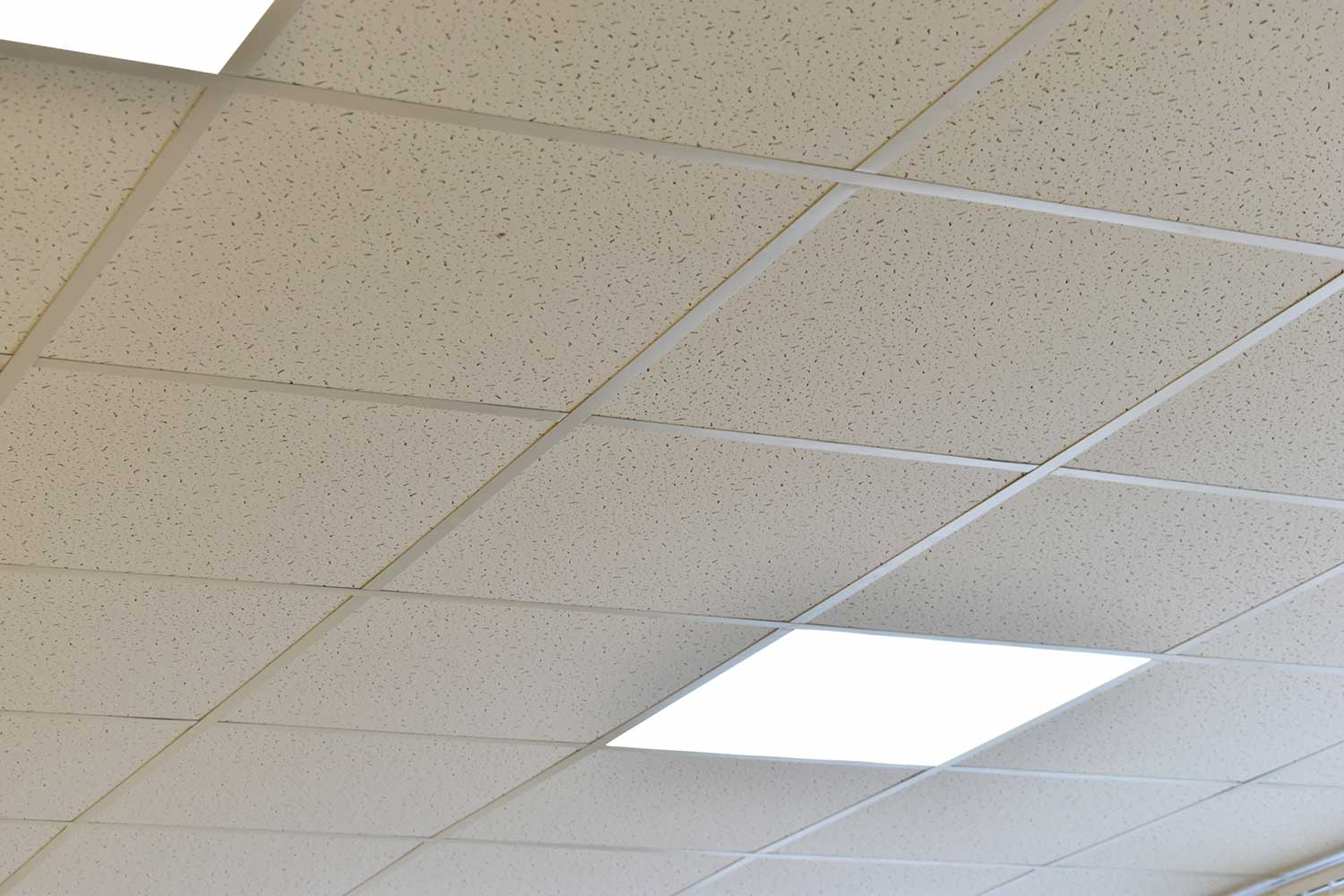Ceiling tiles can be a great way to add a bit of flair to your home decor. Cutting and installing them, however, does require a bit of planning. Cutting the ceiling tiles properly is crucial to ensure sufficient ceiling coverage and uniformity. In this guide, we'll show you the best methods for cutting ceiling tiles so that you can get the results that you're aiming for with your home project.
The most common types of ceiling tile materials are fiberboard (the common "fissure-textured" tile), plastic, tin, and mineral wool (commonly used for acoustic panels). Below is an overview of the steps to cut these types of ceiling tiles:
- Measure your tiles to make sure that they will sufficiently cover the ceiling area.
- Mark the ceiling tiles that will need to be cut.
- Score the ceiling tile with a boxcutter (or acrylic tool).
- Cut the tile using a boxcutter or drywall saw, depending on the material.
While cutting the tiles for your ceiling is not a particularly difficult task, it is one that requires precise measuring and accurate scoring. If you have never cut or installed any type of building structure for your home, it may be best to leave this task in the hands of a professional contractor. Let's take a deeper look at the steps to cut each specific ceiling tile material as well as the tools you'll need.
![A suspended ceiling with LED square lamps in the office, How To Cut Ceiling Tiles? [4 Steps]](https://uooz.com/wp-content/uploads/2020/11/How-To-Cut-Ceiling-Tiles-.jpg)
Before You Get Started
There are some tools and equipment that you'll need to have on hand before you start this task. These items include:
- Safety goggles
- Respirator mask
- Thick protective gloves
- Boxcutter
- Acrylic scoring tool
- Carpet knife
- Tape measure
- Pencil
- Tin snips
- T-square ruler
- Marking Pen
- Scrap plywood
Now that you have all the necessary equipment, let's take a look at the steps required to cut the various types of ceiling tiles.
How To Cut Plastic Ceiling Tiles
Step 1. Measure
Take accurate measurements of the entire ceiling area where the ceiling tiles will be placed. It's recommended to add about an eighth of an inch on each side so that the tiles will have enough slack to sit securely on the ceiling's railing grid. When measuring your ceiling tiles, be sure to also add the same amount of extra space as well.
Step 2. Score
At this point, you should put on both your safety goggles as well as your protective gloves. Once cut, the corners and edges of the plastic ceiling tiles will be extremely sharp and may cause injury if they are handled with bare hands. Place the ceiling tile on a level workbench. Next, take your t-square ruler and place it alongside the cutting line. Then, take your scoring tool and, while holding the panel steady, score the panel anywhere from 3 to 5 times, making sure to create a clean and straight cut.
Step 3. Break It Off
Slide the tile to the side of your workbench so that the scored line sits right on the edge. Next, while holding the panel with one hand, use your other hand to push the plastic on the edge toward the floor so that it snaps off in a quick motion. Be sure to remove the scored piece and set it aside. Plastic panels can crack very easily, so it's imperative to score the plastic accurately and deep enough so that it breaks on the scoring line. Otherwise, you may find yourself wasting tiles.
Check out these protective gloves on Amazon.
How To Cut Tin Ceiling Tiles

Step 1. Measure
Take accurate measurements of the entire ceiling area where the ceiling tiles will be placed. Next, place the tile face down on your workbench and measure it so that it will fit your total ceiling dimension requirements. Use your marker to place small marker points on the opposite edges of the tile. Then, take your t-square and align it with the marks to make a straight line. This line will be used as your cutting guide for the tin snips.
Step 2. Cut The Tin
Put on your protective gloves. Next, take your tin snips and while holding the tin with one hand, carefully cut along your guideline. Be sure to take your time so that your cut will be straight, as an uneven tile will result in gapping once it's installed. Note: tin ceiling tiles don't have railing grids, so they'll be placed next to one another once installed.
Step 3. Continue The Process
Place the cut tile aside and move on to the next piece. Be careful when handling the corners of the tiles, as they can be extremely sharp.
Check out these tin snips on Amazon.
How To Cut Fiberboard ("Fissure-Textured") Tiles

Step 1. Measure
Take accurate measurements of the entire ceiling area where the ceiling tiles will be placed. Next, set the tile down face-up on your workbench or table. Then, using your pencil, mark the tile on the top and bottom edges to use this as a guideline. Again, be sure that when you measure the ceiling and the tile to add an eighth of an inch so that you can account for the grid area on which the edges of the tile will sit.
Step 2. Score
Next, take your t-square and set it on the tile so that it's lined up with the guideline that you just made. Then, while holding the ceiling tile with one hand, use your box cutter to score the panel along the guideline approximately 3-5 times. It's important to score the tile repeatedly and deeply so that it creates a precise cut.
Step 3. Break It Off
Slide the tile to the other side of your workbench so that the scored line is right on the edge. Next, while holding the panel with one hand, use your other hand to firmly push the board on the edge toward the floor so that it breaks off. You may need to tilt the board back and forth to score it again to cut through the paper backing. Once you've cut the board completely, set the scrap aside, and then prepare to measure your next piece.
Check out this box cutter on Amazon.
How To Cut Acoustic Panel Tiles
Step 1. Measure
Take accurate measurements of the entire ceiling area where the acoustic panel will be placed. You may want to place a piece of scrap plywood or other material on top of your workbench so that it will not be cut when you use your carpet knife to score the panel. Next, set the panel down face-up on your workbench or table.
Then, using your pencil, mark the panel on the top and bottom edges to use as a guideline. Be sure when measuring the ceiling and the panel to add an eighth of an inch so that you can account for the grid area on which the edges of the panel will sit.
Step 2. Make The Cut
Next, take your t-square and set it on the panel so that it's lined up with the guideline that you just made. Then, while holding the ceiling panel with one hand, use your carpet knife to score the panel along the guideline approximately 3-5 times (more may be necessary). It's important to score the panel repeatedly and deeply so that it makes a precise cut.
While the material of the panel will not be sharp when it's cut (it's usually mineral wool), it's still best to wear protective gloves as a safety precaution-- carpet knives are extremely sharp.
Step 3. Break It Off
Slide the panel to the other side of your workbench so that the scored line is right on the edge. Next, while holding the panel with one hand, use your other hand to firmly push the board on the edge toward the floor so that it breaks off. You may need to tilt the panel back and forth a bit before it breaks off completely. Once you've cut the board completely, set the scrap aside, and then prepare to measure your next piece.
What Is Another Name For Drop Ceiling?
A dropped ceiling is often also referred to as a secondary ceiling or a suspended ceiling. Other common names for it include a false ceiling and a T-bar ceiling.
What Are Drop Ceiling Tiles Made From?
Most drop ceiling tiles are made from either mineral fiber or fiberglass. However, they can also be made with polystyrene (a type of plastic), cellulose, perlite, or vinyl. The various materials used to create these tiles allows them to offer various patterns, designs, and textures.
What Is The Standard Size Of Ceiling Tile?
For the most part, there are two main sizes of ceiling tiles (for industrial buildings and home use) that are produced on a massive scale: 2x4 feet and 2x2 feet. Ceiling tiles typically come in cases of 32, 64, or 80 pieces, and can be found at most home improvement stores in bulk.
Is Ceiling Tile Dust Bad For You?
Yes, ceiling tile dust can pose health risks to humans and pets. When installing, cutting, or removing ceiling tile, it's strongly recommended that you cover your skin completely as well as wear a respirator mask. Because ceiling tile is typically made from mineral or fiberglass, not only can it irritate the skin and cause a rash, but inhaling it (particularly in large amounts) can cause respiratory issues.
This is because the dust particles from ceiling tiles have the ability to deeply penetrate the lungs and cause serious and even fatal lung problems such as lung cancer and silicosis. The dust from ceiling tiles can also cause kidney issues.
There's also a health risk with ceiling tiles that contain asbestos, which is known to cause respiratory disease and other health issues.
Wrapping Things Up
We hope that this step-by-step guide has given you a map on how to go about installing cutting your ceiling tiles. If you are planning to perform this task on your own, be sure to wear protective equipment that includes protective gloves, skin coverings, and a protective respirator mask.
Before you go, be sure to check out our other posts:



